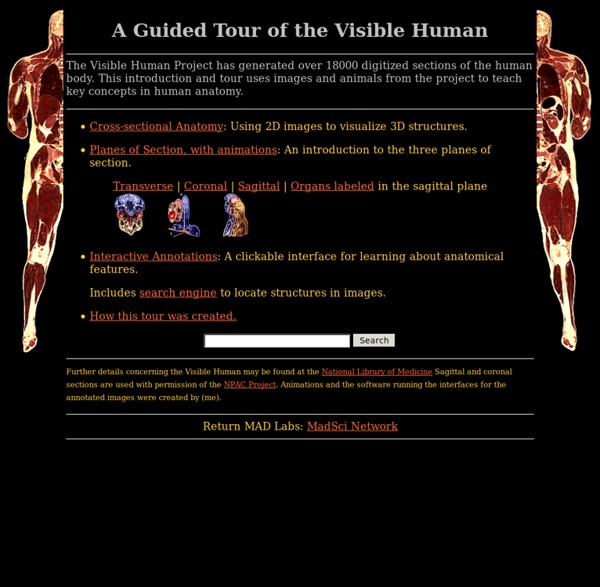



Virtual Body Master Muscle List Home Page 6 Virtual Tours Of The Human Body For Free Interactive Anatomy Lessons When it comes to interactive virtual views, we have gone to space and around the globe. So, it’s not surprising that we are also going within ourselves on a virtual journey of the human body. One of the finest tools available online is Visible Body. Unfortunately, it’s not free anymore. But you can see the beauty of it thanks to the free demo that allows you to explore the head and neck. If you are disappointed that there aren’t any free interactive anatomy tools, worry not. Google Body You can trust Google to take you everywhere. The Google Body browser is a Google Labs project that renders on Google Chrome and any other browser that supports WebGL (like Firefox 4 Beta). MEDtropolis The interactive website aims to educate entertain both kids and adult on bodily health; understanding the human anatomical structure is just part of the process. For instance, check out the narrated tours on Virtual Body. eSkeletons eSkeletons isn’t only about understanding human anatomy. DirectAnatomy
Brain Atlas - Introduction The central nervous system (CNS) consists of the brain and the spinal cord, immersed in the cerebrospinal fluid (CSF). Weighing about 3 pounds (1.4 kilograms), the brain consists of three main structures: the cerebrum, the cerebellum and the brainstem. Cerebrum - divided into two hemispheres (left and right), each consists of four lobes (frontal, parietal, occipital and temporal). The outer layer of the brain is known as the cerebral cortex or the ‘grey matter’. It covers the nuclei deep within the cerebral hemisphere e.g. the basal ganglia; the structure called the thalamus, and the ‘white matter’, which consists mostly of myelinated axons. – closely packed neuron cell bodies form the grey matter of the brain. Cerebellum – responsible for psychomotor function, the cerebellum co-ordinates sensory input from the inner ear and the muscles to provide accurate control of position and movement. Basal Ganglia Thalamus and Hypothalamus Ventricles Limbic System Reticular Activating System Neurons Glia
Neuroscience For Kids The smell of a flower - The memory of a walk in the park - The pain of stepping on a nail. These experiences are made possible by the 3 pounds of tissue in our heads...the BRAIN!! Neuroscience for Kids has been created for all students and teachers who would like to learn about the nervous system. Discover the exciting world of the brain, spinal cord, neurons and the senses. Can't find what you are looking for? Portions of Neuroscience for Kids are available in Spanish, Slovene, Portuguese, Italian, Korean, Japanese, Serbian, Russian, Slovak, Romanian, Polish, Albanian, Czech, Finnish, Estonian, Hungarian, Punjabi, Indonesian, Malay, Norwegian, Ukranian and Turkish. "Neuroscience for Kids" is maintained by Eric H.
bodies-in-motion - scott-eaton.com 30 second sequences from BiM Not long ago, I had twelve artists from Natural Motion (of Morpheme and Clumsy Ninja fame) into Somerset House, my home away from home, for a four day anatomy workshop. At the end of each day we would take about 20 minutes to draw from the Bodies in Motion library. sketching from BiM We made extensive use of the timer for gesture drawing. timelapse of a sequence of 30 second poses Glutamate by Niels Chr. Danbolt For more references and more information, see: Danbolt, 2001: Prog. Neurobiol. 65, 1-105. Glutamate Outside the community of biomedical scientists, glutamate is probably best known as "monosodium glutamate" or "MSG" which is used as a flavor or taste enhancer in food. Glutamate is the major excitatory transmitter in the brain The main motivation for the ongoing World Wide research on glutamate is due to the role of glutamate in the signal transduction in the nervous systems of apparently all complex living organisms, including man. Glutamate is toxic, not in spite of its importance, but because of it Glutamate does not only mediate a lot of information, but also information which regulates brain development and information which determines cellular survival, differentiation and elimination as well as formation and elimination of nerve contacts (synapses). Glutamate is taken up into both glial cells and nerve terminals. Types of glutamate transporting proteins
Body proportions While there is significant variation in anatomical proportions between people, there are many references to body proportions that are intended to be canonical, either in art, measurement, or medicine. Similarly, in art, body proportions are the study of relation of human or animal body parts to each other and to the whole. These ratios are used in veristic depictions of the figure, and also become part of an aesthetic canon within a culture. Basics of human proportions[edit] Human proportions marked out in an illustration from a 20th century anatomy text-book. Different proportions in different people. It is important in figure drawing to draw the human figure in proportion. The proportions used in figure drawing are:[citation needed] Western ideal[edit] Leg-to-body ratio[edit] Another study using British and American participants, found "mid-ranging" leg-to-body ratios to be most ideal.[8] Muscle men and thin women[edit] Japanese ideal[edit] Leonardo da Vinci[edit] Additional images[edit]
All Stomach Muscles Anatomy And Abdominal Muscles Exercises